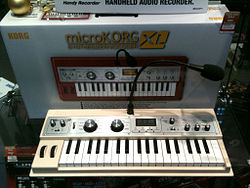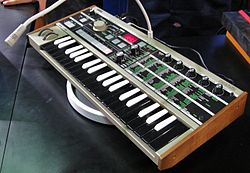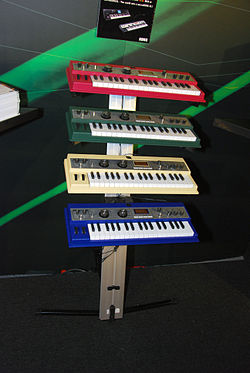- microKORG
-
The microKORG is a MIDI-capable virtual analog synthesizer/vocoder from Korg featuring high-quality DSP analog modelling. The synth/keyboard is built in such a way that it is essentially a Korg MS-2000 with programmable step arpeggiator (MS-2000 has only six simple patterns), a less advanced vocoder (8 bands instead of 16 bands found on the MS-2000), lack of motion sequencing (MS-2000 had three motion sequences), lack of an XLR microphone input, and in a smaller case with fewer real-time control knobs.
The microKORG was released in 2002 and is still in production as of 2011[update]. In September 2007 Korg released a limited edition of the microKORG with reverse-color keys although the functionality was otherwise unchanged. At NAMM 2008, a successor called the microKORG XL was introduced.[1] Available since early 2009 it uses MMT Multi Modeling Technology from Korg's newer and more powerful Radias/R3 synthesizers.
Contents
Synthesis
The microKORG uses DSP technology to emulate the sounds of an analog synthesizer using firmware. The fundamental unit of sound is, in Korg's terminology, a "timbre". This is generated with a pair of multi-function oscillators. Two timbres can be combined to create a four-oscillator "layer". This can be used to create more complex sounds, although it halves the polyphony from four notes to two. A single timbre can be played in four-voice. Oscillator one (OSC1) can produce one of several fundamental waveforms, including saw, square, triangle, and sine waves. Alternatively, OSC1 can produce a vox wave (for simulating human vocal cords), white noise, and one of 64 different digital waveforms that were created by harmonic additive synthesis. Some of these 64 waveforms were originally featured in the Korg DW-8000 digital synthesizer of the late 1980s. The second oscillator (OSC2) is limited to saw, square, and triangle waveforms.
Each waveform on OSC1 has a unique modulation feature, including wave morphing, Pulse-width modulation, and FM. OSC2 can be detuned, synchronized, and/or ring-modulated with OSC1 in order to create more complex sounds. OSC1 can also be replaced with the signal from one of the line-level inputs on the back of the unit, allowing external signals to be processed with the effects and filters of the microKORG, or potentially ring-modulated by OSC2.
The microKORG also uses effects such as flange, ensemble, phaser, and digital delay, which can also be applied to external signals. The unit also features two independent LFOs, with six different waveforms, which can be used to create more complex modulations.
When playing a single timbre the keyboard has four-voice polyphony. In layer mode it generally has two-voice polyphony, although one combination of polyphonic/mono layers allows for three-voice polyphony of the second timbre.
The microKORG groups its 128 factory preset sound patches into 8 groups:
A large knob changes the selected sound group. Each group has 16 different patches (2 banks of 8), selected by the 8 lighted buttons on the front with a side A/B button to toggle between sets of 8. All patches are user editable, and do not necessarily have to follow the groupings listed on the face plate.
Samples of microKORG sound: Ring X-Mod, Star Sky, Alien World, Crystal and Trance (microKORG internal demo song).
Creating/editing sounds
The microKORG uses two selector knobs to select between settings and five control knobs to modify the values of those settings. Information is presented on a 3-digit red LED panel on the front of the keyboard, which attempts to display letters using only the 7 segments. These characters can be difficult to understand at first, but can become easier to recognize through use. Through MIDI and software from Korg, all of the settings can be edited on a computer as well.
When not in the Edit mode (which is automatically set by turning any of the two selector knobs or by holding the Shift key and pressing the Side button), the five control knobs control respectively the cutoff frequency, the resonance, the amp envelope attack, the amp envelope release and the global tempo. When moved clockwise or anti-clockwise when not in the Edit mode, those knobs will not make the LED panel display anything new (so it is not possible to fix a specific cut-off amount; the user must proceed approximately instead). In the Edit mode, however, every knob makes the LED panel display the current value associated with the knob position. To change the current value of a given parameter, the user must pass through the original value before being able to modify anything. When on that original value, the Original Value LED will light on, and the value displayed on the LED panel will stop flashing. This avoids the user from passing from a small to a high value immediately, so there's no big margin in the change of the parameters (a useful function for live performances).
Features
- Modeled after old analogue synthesisers, including wood side panels, large knobs on the face, and smaller knobs modelled on a Moog synthesiser giving it a fashionable retro look and accessible editing interface.
- Can run on six AA batteries (which are often included in the packaging).
- An Eight-band vocoder is part of the microKORG along with a gooseneck microphone, allowing vocoder functionality right out of the box. Each patch can be used as a vocoder sound, and the vocoder is just as programmable as the synthesizer (with the notable exception of the virtual patch functions, which are replaced with individual panpots and gain controls for each vocoder channel).
- Small and compact (approx. 20.5" by 9").
microKORG XL
The direct successor to the microKORG, the microKORG XL, utilises MMT Analog modelling, and is based on Korg's own R3. The XL features a brand-new LCD display, and two Program Select knobs for easier access.
The microKORG XL groups its 128 factory preset sound patches into 8 groups:
and several sub categories:
New features specific to the microKORG XL
Notably, the microKORG XL features 17 different KAOSS derived effects, including phaser, flange, decimation, vibrato, tremolo and retrigger. The XL also features several included PCM Waveforms, including Piano, Brass Ensemble, 9 Electric Piano and Clavinet, 7 organ sounds (one of which emulates the Korg M1 Organ), a full String Orchestra, 2 variable formant waves and more than 32 digitally generated waveforms (SYNWAVE 6 is a ramp wave/inverted sawtooth.) Another new feature of the XL is Waveform Modulation types including Phase Modulation, Cross modulation, Frequency Modulation and Ring modulation. microKORG XL also notably includes a Unison Simulator (in which 5 stacked oscillators within 1 oscillator can be detuned and phased to achieve a richer sound.) The Unison Simulator is similar to the Supersaw waveform on the Roland JP-8000, but can create even more The included "OSC MOD WAVEFORM" and "OSC2 SYNC" controllers are reminiscent of the Poly-Mod feature in the Sequential Circuits Prophet-5. The microkorg XL also includes a waveshaper (uncommon in most synthesisers) which will morph the current waveform into an approximation of the waveform you desire, resulting in a harsh sound. The waveshaper also includes a third oscillator (Sub oscillator.)
Competing products
The MicroKORG was released during the same period as several similar products:
- Alesis Micron
- Novation KS Series / Novation Xio-Synth
- Dave Smith Evolver
- Akai Miniak
The microKORG shared several features with the earlier, discontinued Quasimidi Sirius - in particular a built-in vocoder - although the Sirius used distinctively unique analog modeling - sample playback hybrid synthesis.
Notable users of microKORG or microKORG XL
- Polysics
- The Prodigy
- Roy Davis (producer)
- Round Turn and Two Half Hitches
- Röyksopp
- Soulwax
- Spike Sent (producer)
- Steve Levine (producer)
- Swords
- Tame Impala
- Pet Shop Boys
- Trentemøller
- Vince Clarke
- VNV Nation
- White Lies
- Winter Gloves
- Wintersleep
- Yeah Yeah Yeahs
- yourcodenameis:milo
A microKORG preset is audible at the beginning of Snoop Dogg's video "Lay Low," (produced by Dr. Dre), and the synth also appears in Snoop's video for "Drop It Like It's Hot" (produced by the Neptunes). The Yeah Yeah Yeahs video "Heads Will Roll" likewise features a microKORG. The Microkorg preset A.73 can be heard in the Black Eyed Peas song "Just Can't Get Enough." Some artists feature on Korg's official website.
References
External links
Categories:- Korg synthesizers
- Virtual analog synthesizers
Wikimedia Foundation. 2010.






